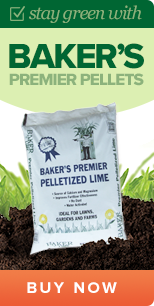Safety and Best Practices for Using Lime
Author/Reviewed By: Josh Miller, Sales Manager: Baker Lime & North America Minerals
Published: 5/12/2025
Lime is a common yard fertilizer component due to its pH-balancing abilities and its cost-effectiveness. Although many homeowners know that a lime fertilizer treatment will help their grass grow faster and greener, some hesitate to use it out of concern about its effects on their family’s health.
Fortunately, it is possible to use lime safely. The primary determinant in its potential to become a human health risk breaks down into one general factor — whether the lime is caustic (fast-acting but harmful) or non-caustic (safe but slightly less effective).
If you’re considering a lime fertilizer for your yard care routine, it’s crucial to pick a type of lime yard treatment that’s safe for adults, kids and pets alike. In addition to selecting the right lime-based fertilizer for your lawn needs, you also need to follow specific guidelines when handling any kind of lime.
Keep reading to learn the basics of garden lime safety and how you can grow your lawn without exposing your family to hazardous che
Is Lime Dust Harmful to Humans?
Whether lime is harmful or not depends on the type of lime and how you use it. Lime is a calcium and magnesium compound that fertilizer manufacturers add to their mixes to aid in lawn pH balance, which helps lawns grow faster. However, there are two general categories of garden lime that differ substantially in their safety factors. These two categories are non-caustic and caustic lime, and both are commonly used in landscaping.
Caustic lime, also known as “burned lime,” undergoes roasting to remove carbon dioxide. This process gives caustic lime the ability to chemically corrode or “burn,” which makes this form of lime dangerous to breathe and touch. Caustic lime includes quicklime and hydrated lime — products that should be avoided in home gardening and lawn care projects. Since this lime is dangerous, failure to handle caustic lime properly can result in chemical burns to humans, animals and even the grass itself.
Ground from regular limestone, non-caustic lime contains mostly calcium carbonate. The most common varieties of non-caustic lime include calcitic limestone and dolomitic lime, and each type is safe to use in your garden. While these non-caustic lime varieties are safe, you still need to exercise certain precautions when using them in your yard.
Avoiding Common Lime Application Mistakes
Applying too much lime to your grass raises the soil’s pH, making it more challenging for grass to grow, and it may even kill the grass over time. This process is slow and may take weeks or months to cause noticeable damage to your lawn.
Lime can burn your grass if too much dust stays behind on the blades after you apply it. Be sure to water your lawn after using lime to remove any excess dust from grass blades.
Best Practices for Using Lime
To avoid coming into contact with lime, you can follow a few steps to use it correctly. There are also safety measures you can take if a person comes into contact with some lime dust.
Steps to Ensure Safe Lime Application
When applying non-caustic lime fertilizer to your lawn, keep the following safety measures in mind to ensure that you and your family stay safe:
- To avoid breathing in lime dust, wear a mask while handling or applying it.
- Always wear gloves and glasses to prevent contact with your eyes and skin.
- Keep kids and pets away from the lime application area until the pellets dissolve, as the exposure may irritate their skin.
To allow the lime to settle properly on your lawn and prevent anyone from touching it without protection, wait until the lime has been thoroughly absorbed before anyone walks on the grass — a heavy rain, or watering the area yourself, are ideal ways to help pellets dissolve.
What to Do If You Get Lime on You
When you follow the correct application methods, non-caustic lime used for your lawn is safer than caustic lime and there are safety measures you can take to avoid potential irritation if the lime should come into contact with you or someone else.
Regardless of where the lime comes into contact, wipe the dust off and avoid using water, which activates the lime. The exception to this is if someone should get lime in their eyes, in which case you can use plenty of water to flush the lime out.
If someone inhales lime dust, moving them to a ventilated area will help. You can give a person milk or water to drink if they accidentally ingested lime dust.
Contact Baker Lime for Safe Lime Yard Treatments
Upgrade your lawn this spring with non-caustic lime from Baker Lime. We offer a wide selection of safe, economical lawn fertilizers, feeds, agricultural supplies and much more! Find a distributor near you and contact our friendly team today for more information on our products.








